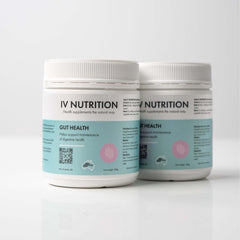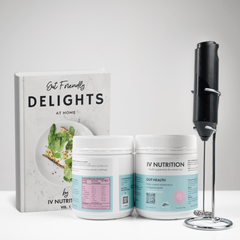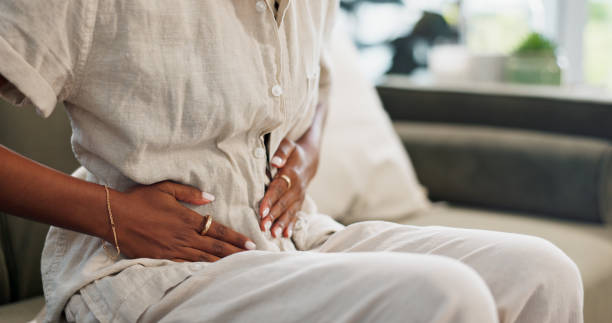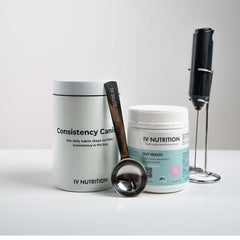What Are the Symptoms of Bad Constipation? A Clinical Deep Dive With a Gut-Friendly Solution
Let’s be honest—talking about constipation isn’t exactly dinner party conversation. But if you’ve ever experienced the discomfort, bloating, or the frustrating “I-need-to-go-but-can’t” feeling, you know it’s not something to laugh off (though a little humor can help).
Constipation is more than just “not going.” It's a complex, often misunderstood condition that affects millions of people—and it can significantly impact your quality of life.
In this post, we'll explore:
-
What bad constipation really is
-
The common and not-so-common symptoms
-
What causes it
-
When to worry
-
And most importantly—how to find relief that’s backed by science, not social media fads
Along the way, we’ll introduce a gentle, natural solution that can help get things moving: prebiotic fiber, with a special spotlight on IV Nutrition’s Virgin Manufactured Sugarcane Prebiotic Fiber.
🚨 First Things First: What Is “Bad” Constipation?
Constipation isn’t just going to the bathroom less often. Clinically, it’s defined by the Rome IV Criteria, which include two or more of the following over the past three months:
-
Fewer than three spontaneous bowel movements per week
-
Straining during more than 25% of bowel movements
-
Hard or lumpy stools (Bristol types 1 and 2)
-
Sensation of incomplete evacuation
-
Feeling of blockage
-
Needing to use manual maneuvers to facilitate defecation
In other words, if you’re pushing, pausing, panicking—or all three—you’re not alone, and you might be dealing with more than “just a little backed up.”
📚 Source: Rome IV Criteria via Gastro Journal
🩺 What Are the Symptoms of Bad Constipation?
The symptoms range from mildly annoying to seriously disruptive. Let’s break them down:
1. Infrequent Bowel Movements
If you're not pooping at least three times per week, it's likely you're constipated. And no, it’s not normal to go only once every 7–10 days.
2. Hard or Lumpy Stools
The type of stool is just as important as how often you go. Hard stools often indicate that the colon is absorbing too much water, leading to dry, difficult-to-pass stool.
🔍 Want to check your stool health? Refer to the Bristol Stool Chart, a medically used guide.
3. Straining or Pain During Bowel Movements
If your bathroom visits feel like a weightlifting competition, your digestive system is waving a red flag.
4. Bloating and Abdominal Discomfort
Gas gets trapped, food moves slowly, and your abdomen may feel swollen, tight, or painful.
5. Feeling Like You Haven’t Fully Emptied
That incomplete evacuation feeling can leave you uncomfortable all day—often with persistent pressure in the rectum.
6. Nausea or Loss of Appetite
When your digestive tract backs up, it can slow gastric emptying, making you feel full or nauseous even without eating much.
7. Bad Breath or Body Odor
When waste sits too long, toxins can reabsorb and lead to systemic symptoms—including bad breath and even breakouts.
8. Mood Changes
Yes, really. Constipation has been linked to anxiety, depression, and fatigue—thanks to the gut-brain axis (Harvard Health).
👶 Constipation Isn’t Just an Adult Problem
Children and older adults are particularly vulnerable. In fact, over 33% of adults over 60 suffer from chronic constipation due to decreased gut motility, medications, and changes in diet and hydration.
📚 Source: National Institute on Aging
🧠 What Causes Bad Constipation?
There are many contributing factors:
| Factor | Explanation |
|---|---|
| Low Fiber Intake | Without dietary fiber, stool lacks bulk and softness |
| Dehydration | Water is absorbed from stool in the colon, making it harder |
| Sedentary Lifestyle | Physical activity helps move things through your gut |
| Medications | Painkillers, antidepressants, and iron supplements can slow motility |
| Stress | Alters gut function through the gut-brain axis |
| Gut Dysbiosis | An imbalance of good and bad bacteria in your gut |
💩 Let’s Talk Fiber: The Natural Hero of Digestion
Fiber is often the missing piece of the puzzle—especially prebiotic fiber, which does more than just bulk up your stool.
What Are Prebiotics?
Prebiotics are non-digestible fibers that nourish your good gut bacteria. They help produce short-chain fatty acids like butyrate, which fuel colon cells, reduce inflammation, and enhance motility.
📚 Learn more from Monash University’s prebiotic guide
🌱 Natural Sources of Prebiotics
You can find prebiotics in:
-
Chicory root
-
Garlic and onions
-
Green bananas
-
Leeks
-
Whole grains like oats and barley
But let’s be real—not everyone wants garlic breath or artichoke smoothies every day.
✨ Spotlight: IV Nutrition’s Virgin Sugarcane Prebiotic Fiber
If you're looking for an easy, gentle way to increase your prebiotic intake, IV Nutrition’s Gut Health Formula made from virgin sugarcane fiber is an ideal choice.
Why Sugarcane Fiber?
This unprocessed fiber is a natural prebiotic powerhouse, rich in both soluble and insoluble fibers. That means:
-
Soluble fiber: Soaks up water, softens stool, and helps you pass it more easily
-
Insoluble fiber: Adds bulk and moves stool through your colon efficiently
Plus, sugarcane fiber is low in FODMAPs, making it easier to tolerate for those with IBS.
Benefits of IV Nutrition’s Gut Health Formula:
✅ 100% natural, virgin sugarcane fiber
✅ Feeds beneficial gut bacteria
✅ Supports regular, smooth bowel movements
✅ Reduces bloating and gas
✅ Easy to mix—flavorless and versatile
✅ Gentle on sensitive stomachs
🎉 Special Offer: 100% Off Your First Tub
IV Nutrition is currently offering a 100% discount on your first tub of their Gut Health prebiotic fiber when you subscribe.
🎁 👉 Click here to claim your offer
There’s never been a better time to show your gut some love.
🩻 When Should You See a Doctor?
While most cases of constipation can be treated with lifestyle changes and prebiotics, it’s important to see a healthcare provider if you experience:
-
Blood in your stool
-
Unexplained weight loss
-
Severe abdominal pain
-
Sudden changes in bowel habits
-
No bowel movements for more than a week
Chronic constipation can be a symptom of underlying conditions like hypothyroidism, IBS-C, or even colorectal cancer.
🧘 Lifestyle Tips That Actually Help
Pair your prebiotic fiber with these evidence-based tips:
🧴 Hydrate – Drink at least 2–3 liters per day
🏃 Exercise – Even a brisk walk gets things moving
🧂 Eat Real Food – Prioritize plants and whole grains
🧘 Manage Stress – Meditation and deep breathing support gut balance
⏰ Establish a Bathroom Routine – Go at the same time each day
🧻 Don’t Ignore the Urge – Waiting makes things worse
🧠 Final Thoughts: Get Things Moving—Naturally
Constipation isn’t just an inconvenience—it can affect your digestion, mood, energy, and overall health. Fortunately, you don’t need harsh laxatives or questionable teas. The key lies in giving your gut what it needs to thrive: hydration, movement, and prebiotic fiber.
And when it comes to fiber, IV Nutrition’s Virgin Sugarcane Prebiotic Fiber offers a clean, simple, and effective way to restore regularity.
👉 Grab your first tub FREE when you subscribe
Your gut will thank you. So will your mirror. And probably your pants.





